Customer Complaints, False Claims and AAP's Profitability Report
VerifiedAdded on 2021/06/16
|45
|11273
|482
Report
AI Summary
This report examines the issue of customer complaints and their impact on the profitability of Andrew's Airport Parking (AAP), an Australian-based company. The study investigates the reasons behind customer dissatisfaction, including poor service quality, high prices, and staff attitudes, which lead to false damage claims and affect AAP's brand image. The research utilizes a qualitative approach, gathering data through primary and secondary sources, including customer surveys and staff interviews, followed by thematic analysis. The findings reveal a strong correlation between customer dissatisfaction, poor staff responses, and pricing strategies that influence false claims. The report recommends revising pricing, providing staff training, and improving service quality to enhance customer satisfaction, reduce complaints, and ultimately improve AAP's financial performance. The report also includes a literature review, research methodology, findings, discussion, recommendations, and limitations to provide a comprehensive analysis of the problem and potential solutions.
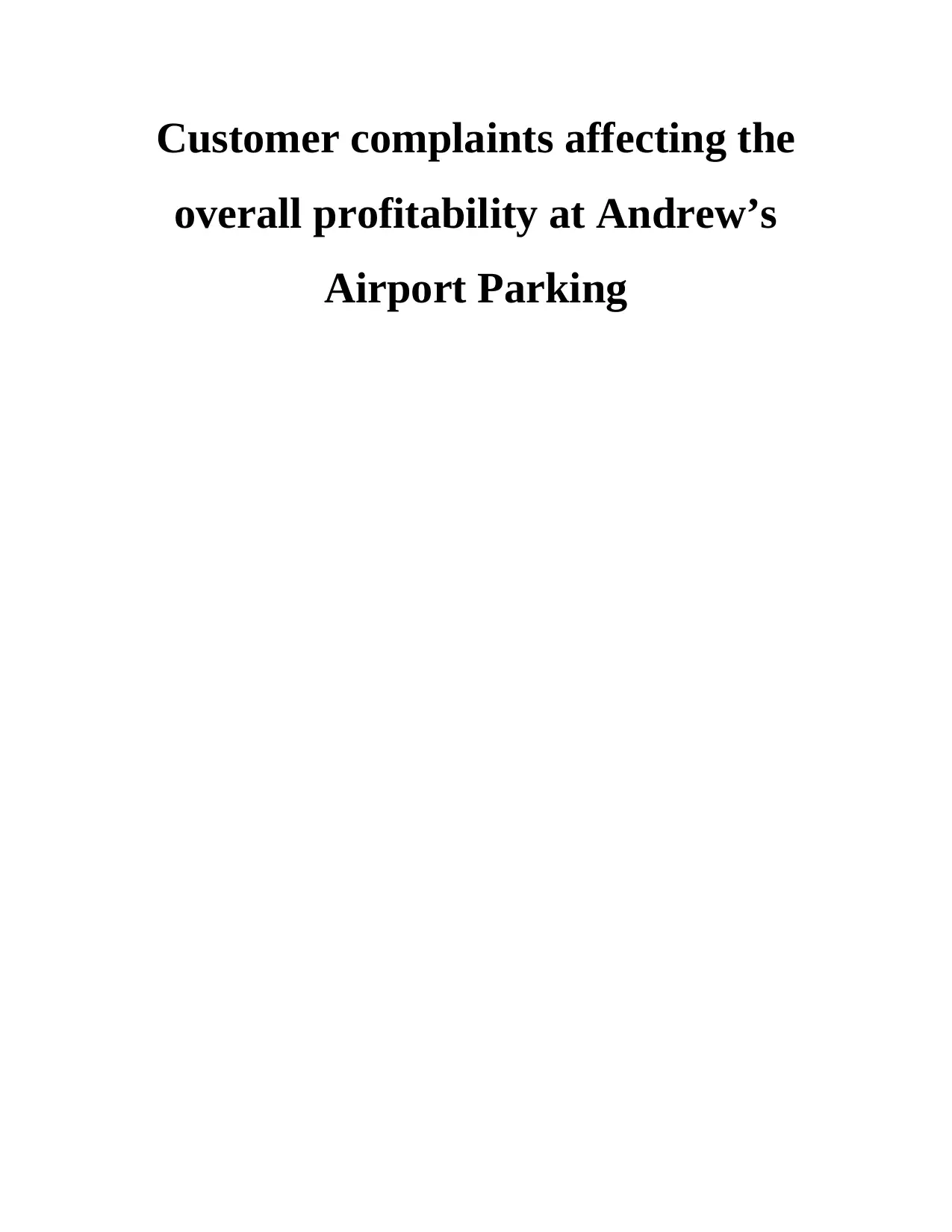
Customer complaints affecting the
overall profitability at Andrew’s
Airport Parking
overall profitability at Andrew’s
Airport Parking
Paraphrase This Document
Need a fresh take? Get an instant paraphrase of this document with our AI Paraphraser
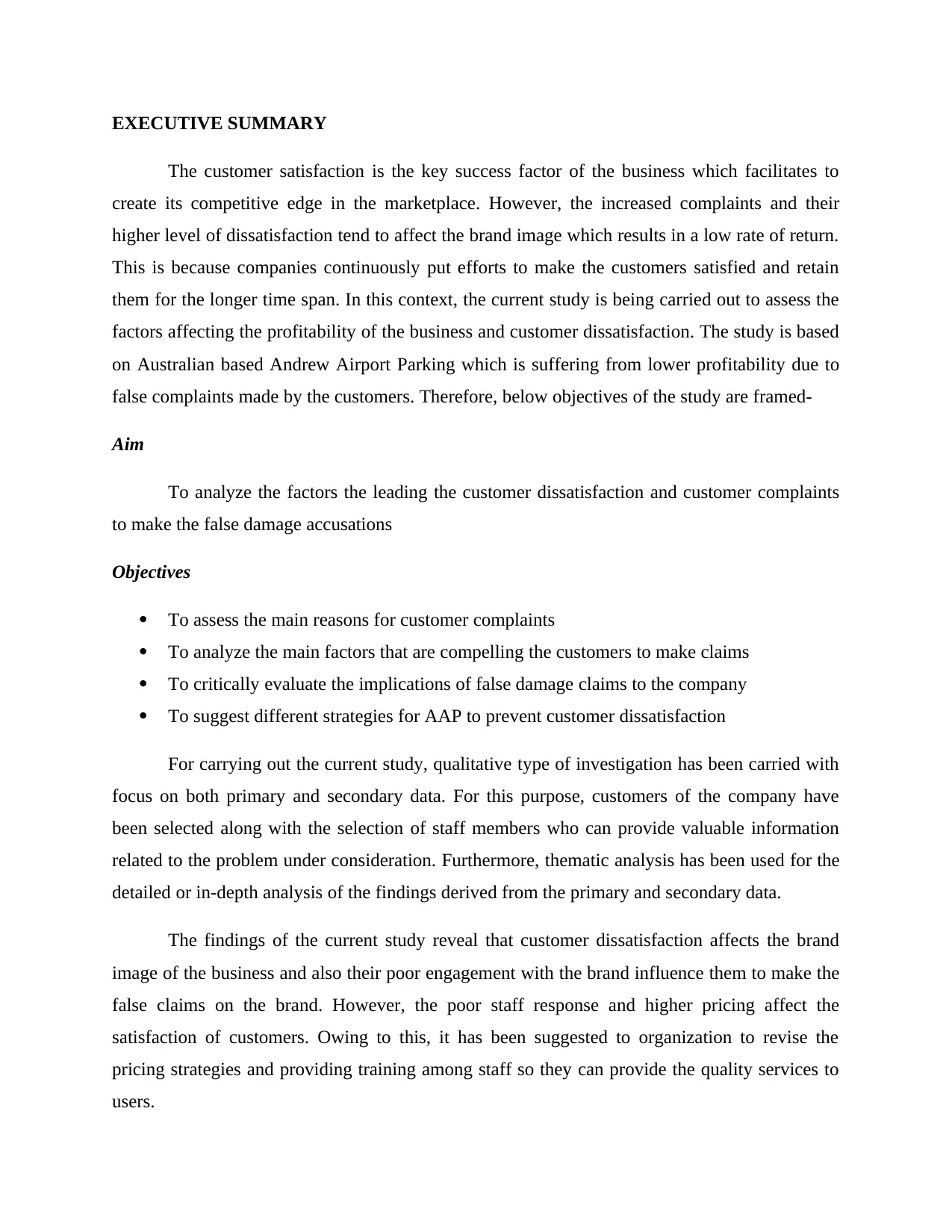
EXECUTIVE SUMMARY
The customer satisfaction is the key success factor of the business which facilitates to
create its competitive edge in the marketplace. However, the increased complaints and their
higher level of dissatisfaction tend to affect the brand image which results in a low rate of return.
This is because companies continuously put efforts to make the customers satisfied and retain
them for the longer time span. In this context, the current study is being carried out to assess the
factors affecting the profitability of the business and customer dissatisfaction. The study is based
on Australian based Andrew Airport Parking which is suffering from lower profitability due to
false complaints made by the customers. Therefore, below objectives of the study are framed-
Aim
To analyze the factors the leading the customer dissatisfaction and customer complaints
to make the false damage accusations
Objectives
To assess the main reasons for customer complaints
To analyze the main factors that are compelling the customers to make claims
To critically evaluate the implications of false damage claims to the company
To suggest different strategies for AAP to prevent customer dissatisfaction
For carrying out the current study, qualitative type of investigation has been carried with
focus on both primary and secondary data. For this purpose, customers of the company have
been selected along with the selection of staff members who can provide valuable information
related to the problem under consideration. Furthermore, thematic analysis has been used for the
detailed or in-depth analysis of the findings derived from the primary and secondary data.
The findings of the current study reveal that customer dissatisfaction affects the brand
image of the business and also their poor engagement with the brand influence them to make the
false claims on the brand. However, the poor staff response and higher pricing affect the
satisfaction of customers. Owing to this, it has been suggested to organization to revise the
pricing strategies and providing training among staff so they can provide the quality services to
users.
The customer satisfaction is the key success factor of the business which facilitates to
create its competitive edge in the marketplace. However, the increased complaints and their
higher level of dissatisfaction tend to affect the brand image which results in a low rate of return.
This is because companies continuously put efforts to make the customers satisfied and retain
them for the longer time span. In this context, the current study is being carried out to assess the
factors affecting the profitability of the business and customer dissatisfaction. The study is based
on Australian based Andrew Airport Parking which is suffering from lower profitability due to
false complaints made by the customers. Therefore, below objectives of the study are framed-
Aim
To analyze the factors the leading the customer dissatisfaction and customer complaints
to make the false damage accusations
Objectives
To assess the main reasons for customer complaints
To analyze the main factors that are compelling the customers to make claims
To critically evaluate the implications of false damage claims to the company
To suggest different strategies for AAP to prevent customer dissatisfaction
For carrying out the current study, qualitative type of investigation has been carried with
focus on both primary and secondary data. For this purpose, customers of the company have
been selected along with the selection of staff members who can provide valuable information
related to the problem under consideration. Furthermore, thematic analysis has been used for the
detailed or in-depth analysis of the findings derived from the primary and secondary data.
The findings of the current study reveal that customer dissatisfaction affects the brand
image of the business and also their poor engagement with the brand influence them to make the
false claims on the brand. However, the poor staff response and higher pricing affect the
satisfaction of customers. Owing to this, it has been suggested to organization to revise the
pricing strategies and providing training among staff so they can provide the quality services to
users.
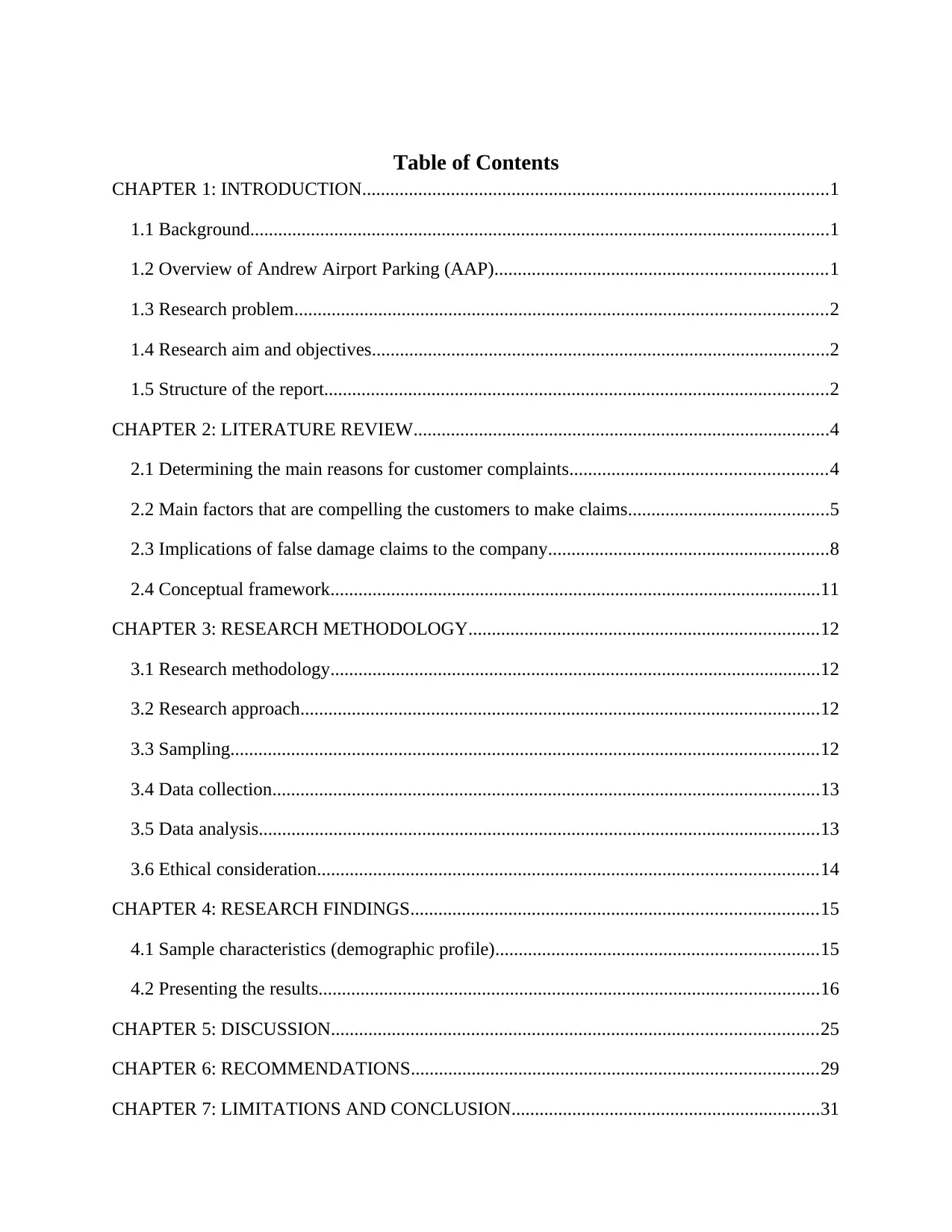
Table of Contents
CHAPTER 1: INTRODUCTION....................................................................................................1
1.1 Background............................................................................................................................1
1.2 Overview of Andrew Airport Parking (AAP).......................................................................1
1.3 Research problem..................................................................................................................2
1.4 Research aim and objectives..................................................................................................2
1.5 Structure of the report............................................................................................................2
CHAPTER 2: LITERATURE REVIEW.........................................................................................4
2.1 Determining the main reasons for customer complaints.......................................................4
2.2 Main factors that are compelling the customers to make claims...........................................5
2.3 Implications of false damage claims to the company............................................................8
2.4 Conceptual framework.........................................................................................................11
CHAPTER 3: RESEARCH METHODOLOGY...........................................................................12
3.1 Research methodology.........................................................................................................12
3.2 Research approach...............................................................................................................12
3.3 Sampling..............................................................................................................................12
3.4 Data collection.....................................................................................................................13
3.5 Data analysis........................................................................................................................13
3.6 Ethical consideration...........................................................................................................14
CHAPTER 4: RESEARCH FINDINGS.......................................................................................15
4.1 Sample characteristics (demographic profile).....................................................................15
4.2 Presenting the results...........................................................................................................16
CHAPTER 5: DISCUSSION........................................................................................................25
CHAPTER 6: RECOMMENDATIONS.......................................................................................29
CHAPTER 7: LIMITATIONS AND CONCLUSION..................................................................31
CHAPTER 1: INTRODUCTION....................................................................................................1
1.1 Background............................................................................................................................1
1.2 Overview of Andrew Airport Parking (AAP).......................................................................1
1.3 Research problem..................................................................................................................2
1.4 Research aim and objectives..................................................................................................2
1.5 Structure of the report............................................................................................................2
CHAPTER 2: LITERATURE REVIEW.........................................................................................4
2.1 Determining the main reasons for customer complaints.......................................................4
2.2 Main factors that are compelling the customers to make claims...........................................5
2.3 Implications of false damage claims to the company............................................................8
2.4 Conceptual framework.........................................................................................................11
CHAPTER 3: RESEARCH METHODOLOGY...........................................................................12
3.1 Research methodology.........................................................................................................12
3.2 Research approach...............................................................................................................12
3.3 Sampling..............................................................................................................................12
3.4 Data collection.....................................................................................................................13
3.5 Data analysis........................................................................................................................13
3.6 Ethical consideration...........................................................................................................14
CHAPTER 4: RESEARCH FINDINGS.......................................................................................15
4.1 Sample characteristics (demographic profile).....................................................................15
4.2 Presenting the results...........................................................................................................16
CHAPTER 5: DISCUSSION........................................................................................................25
CHAPTER 6: RECOMMENDATIONS.......................................................................................29
CHAPTER 7: LIMITATIONS AND CONCLUSION..................................................................31
⊘ This is a preview!⊘
Do you want full access?
Subscribe today to unlock all pages.

Trusted by 1+ million students worldwide
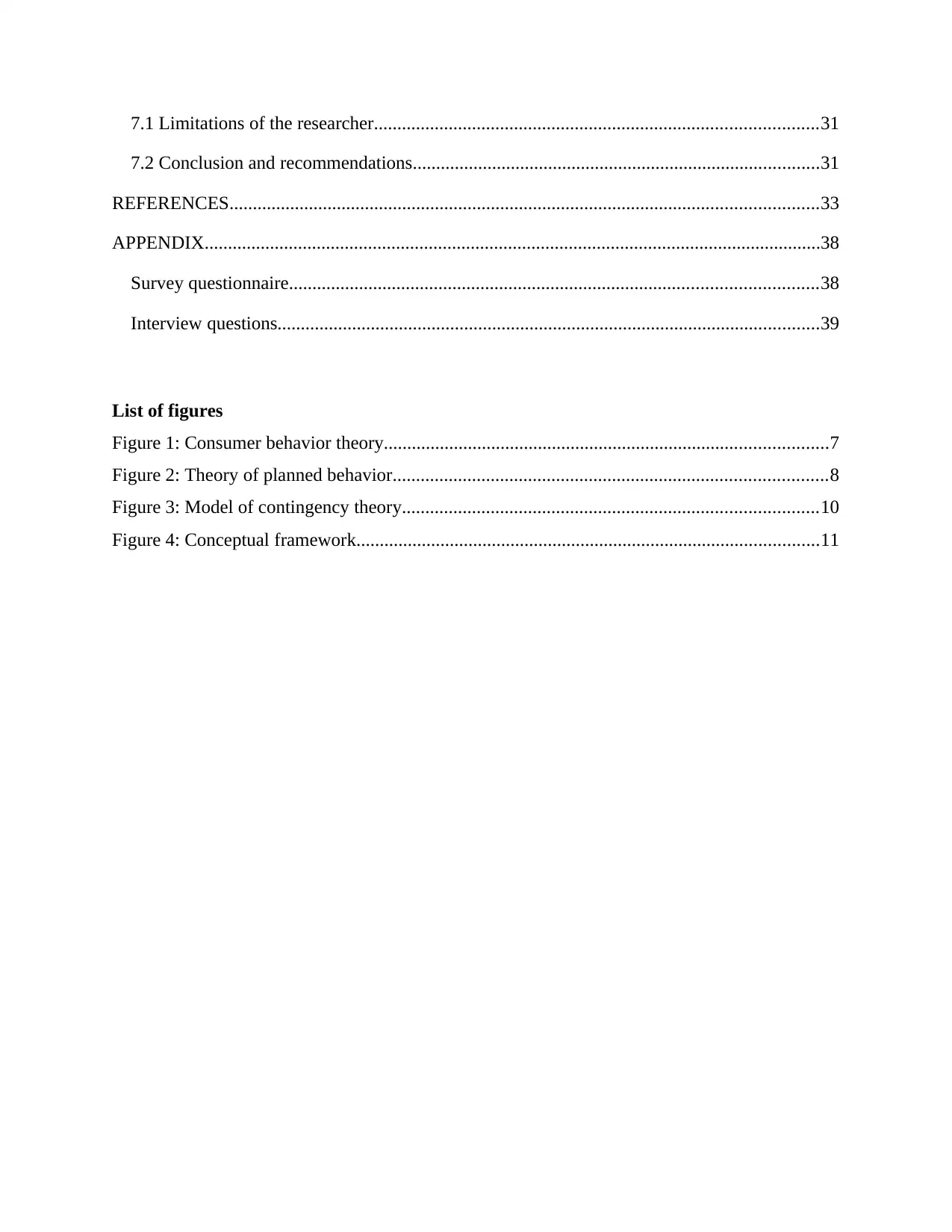
7.1 Limitations of the researcher...............................................................................................31
7.2 Conclusion and recommendations.......................................................................................31
REFERENCES..............................................................................................................................33
APPENDIX....................................................................................................................................38
Survey questionnaire.................................................................................................................38
Interview questions....................................................................................................................39
List of figures
Figure 1: Consumer behavior theory...............................................................................................7
Figure 2: Theory of planned behavior.............................................................................................8
Figure 3: Model of contingency theory.........................................................................................10
Figure 4: Conceptual framework...................................................................................................11
7.2 Conclusion and recommendations.......................................................................................31
REFERENCES..............................................................................................................................33
APPENDIX....................................................................................................................................38
Survey questionnaire.................................................................................................................38
Interview questions....................................................................................................................39
List of figures
Figure 1: Consumer behavior theory...............................................................................................7
Figure 2: Theory of planned behavior.............................................................................................8
Figure 3: Model of contingency theory.........................................................................................10
Figure 4: Conceptual framework...................................................................................................11
Paraphrase This Document
Need a fresh take? Get an instant paraphrase of this document with our AI Paraphraser
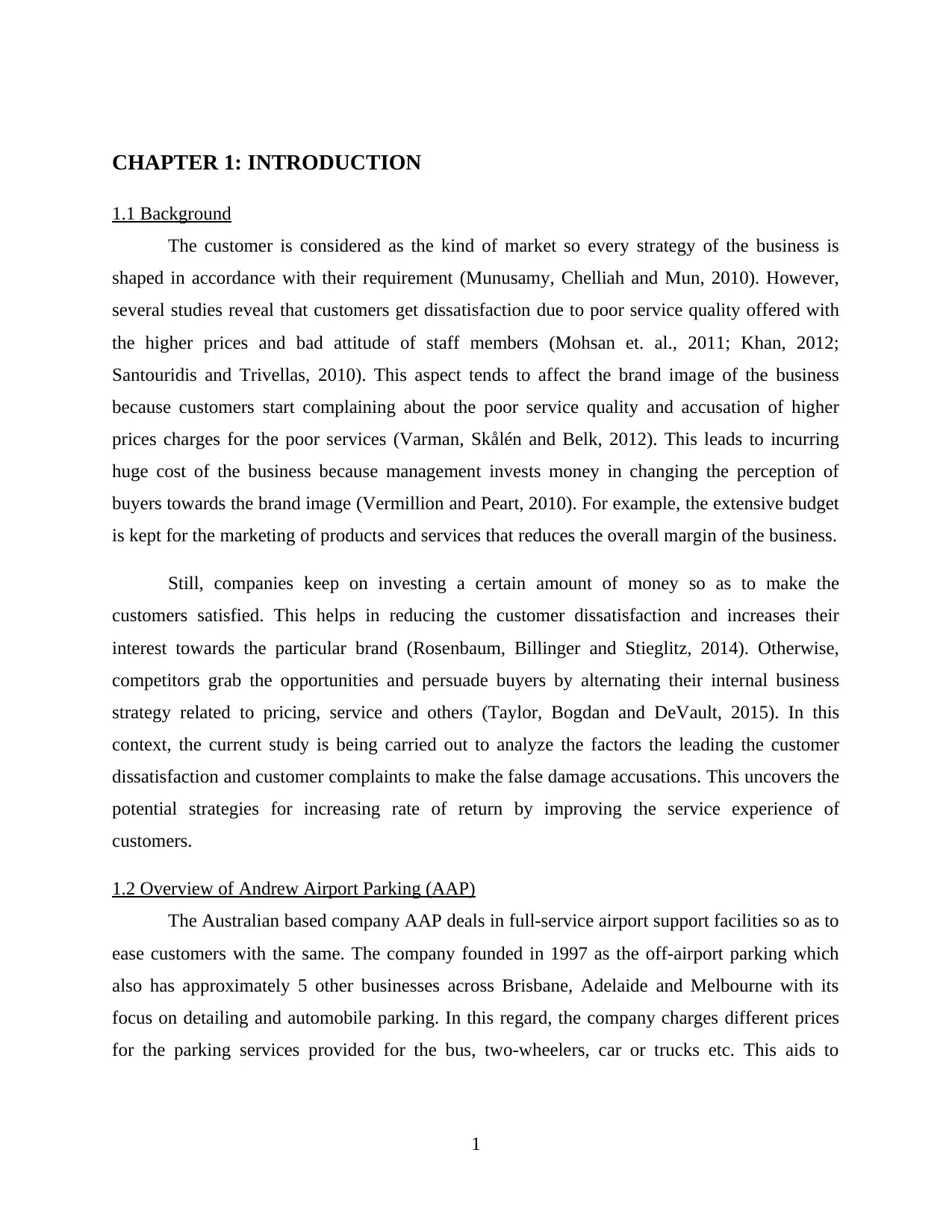
CHAPTER 1: INTRODUCTION
1.1 Background
The customer is considered as the kind of market so every strategy of the business is
shaped in accordance with their requirement (Munusamy, Chelliah and Mun, 2010). However,
several studies reveal that customers get dissatisfaction due to poor service quality offered with
the higher prices and bad attitude of staff members (Mohsan et. al., 2011; Khan, 2012;
Santouridis and Trivellas, 2010). This aspect tends to affect the brand image of the business
because customers start complaining about the poor service quality and accusation of higher
prices charges for the poor services (Varman, Skålén and Belk, 2012). This leads to incurring
huge cost of the business because management invests money in changing the perception of
buyers towards the brand image (Vermillion and Peart, 2010). For example, the extensive budget
is kept for the marketing of products and services that reduces the overall margin of the business.
Still, companies keep on investing a certain amount of money so as to make the
customers satisfied. This helps in reducing the customer dissatisfaction and increases their
interest towards the particular brand (Rosenbaum, Billinger and Stieglitz, 2014). Otherwise,
competitors grab the opportunities and persuade buyers by alternating their internal business
strategy related to pricing, service and others (Taylor, Bogdan and DeVault, 2015). In this
context, the current study is being carried out to analyze the factors the leading the customer
dissatisfaction and customer complaints to make the false damage accusations. This uncovers the
potential strategies for increasing rate of return by improving the service experience of
customers.
1.2 Overview of Andrew Airport Parking (AAP)
The Australian based company AAP deals in full-service airport support facilities so as to
ease customers with the same. The company founded in 1997 as the off-airport parking which
also has approximately 5 other businesses across Brisbane, Adelaide and Melbourne with its
focus on detailing and automobile parking. In this regard, the company charges different prices
for the parking services provided for the bus, two-wheelers, car or trucks etc. This aids to
1
1.1 Background
The customer is considered as the kind of market so every strategy of the business is
shaped in accordance with their requirement (Munusamy, Chelliah and Mun, 2010). However,
several studies reveal that customers get dissatisfaction due to poor service quality offered with
the higher prices and bad attitude of staff members (Mohsan et. al., 2011; Khan, 2012;
Santouridis and Trivellas, 2010). This aspect tends to affect the brand image of the business
because customers start complaining about the poor service quality and accusation of higher
prices charges for the poor services (Varman, Skålén and Belk, 2012). This leads to incurring
huge cost of the business because management invests money in changing the perception of
buyers towards the brand image (Vermillion and Peart, 2010). For example, the extensive budget
is kept for the marketing of products and services that reduces the overall margin of the business.
Still, companies keep on investing a certain amount of money so as to make the
customers satisfied. This helps in reducing the customer dissatisfaction and increases their
interest towards the particular brand (Rosenbaum, Billinger and Stieglitz, 2014). Otherwise,
competitors grab the opportunities and persuade buyers by alternating their internal business
strategy related to pricing, service and others (Taylor, Bogdan and DeVault, 2015). In this
context, the current study is being carried out to analyze the factors the leading the customer
dissatisfaction and customer complaints to make the false damage accusations. This uncovers the
potential strategies for increasing rate of return by improving the service experience of
customers.
1.2 Overview of Andrew Airport Parking (AAP)
The Australian based company AAP deals in full-service airport support facilities so as to
ease customers with the same. The company founded in 1997 as the off-airport parking which
also has approximately 5 other businesses across Brisbane, Adelaide and Melbourne with its
focus on detailing and automobile parking. In this regard, the company charges different prices
for the parking services provided for the bus, two-wheelers, car or trucks etc. This aids to
1
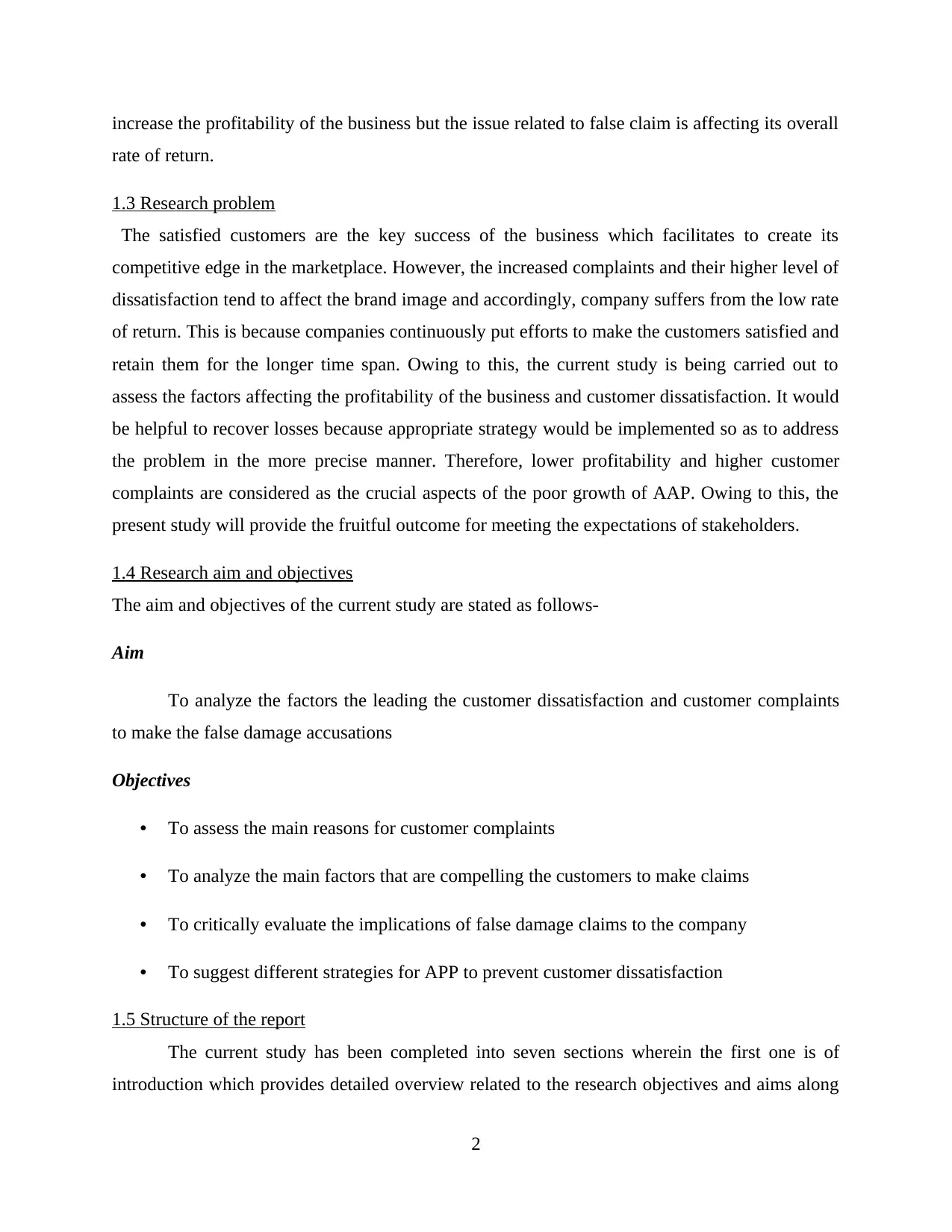
increase the profitability of the business but the issue related to false claim is affecting its overall
rate of return.
1.3 Research problem
The satisfied customers are the key success of the business which facilitates to create its
competitive edge in the marketplace. However, the increased complaints and their higher level of
dissatisfaction tend to affect the brand image and accordingly, company suffers from the low rate
of return. This is because companies continuously put efforts to make the customers satisfied and
retain them for the longer time span. Owing to this, the current study is being carried out to
assess the factors affecting the profitability of the business and customer dissatisfaction. It would
be helpful to recover losses because appropriate strategy would be implemented so as to address
the problem in the more precise manner. Therefore, lower profitability and higher customer
complaints are considered as the crucial aspects of the poor growth of AAP. Owing to this, the
present study will provide the fruitful outcome for meeting the expectations of stakeholders.
1.4 Research aim and objectives
The aim and objectives of the current study are stated as follows-
Aim
To analyze the factors the leading the customer dissatisfaction and customer complaints
to make the false damage accusations
Objectives
• To assess the main reasons for customer complaints
• To analyze the main factors that are compelling the customers to make claims
• To critically evaluate the implications of false damage claims to the company
• To suggest different strategies for APP to prevent customer dissatisfaction
1.5 Structure of the report
The current study has been completed into seven sections wherein the first one is of
introduction which provides detailed overview related to the research objectives and aims along
2
rate of return.
1.3 Research problem
The satisfied customers are the key success of the business which facilitates to create its
competitive edge in the marketplace. However, the increased complaints and their higher level of
dissatisfaction tend to affect the brand image and accordingly, company suffers from the low rate
of return. This is because companies continuously put efforts to make the customers satisfied and
retain them for the longer time span. Owing to this, the current study is being carried out to
assess the factors affecting the profitability of the business and customer dissatisfaction. It would
be helpful to recover losses because appropriate strategy would be implemented so as to address
the problem in the more precise manner. Therefore, lower profitability and higher customer
complaints are considered as the crucial aspects of the poor growth of AAP. Owing to this, the
present study will provide the fruitful outcome for meeting the expectations of stakeholders.
1.4 Research aim and objectives
The aim and objectives of the current study are stated as follows-
Aim
To analyze the factors the leading the customer dissatisfaction and customer complaints
to make the false damage accusations
Objectives
• To assess the main reasons for customer complaints
• To analyze the main factors that are compelling the customers to make claims
• To critically evaluate the implications of false damage claims to the company
• To suggest different strategies for APP to prevent customer dissatisfaction
1.5 Structure of the report
The current study has been completed into seven sections wherein the first one is of
introduction which provides detailed overview related to the research objectives and aims along
2
⊘ This is a preview!⊘
Do you want full access?
Subscribe today to unlock all pages.

Trusted by 1+ million students worldwide
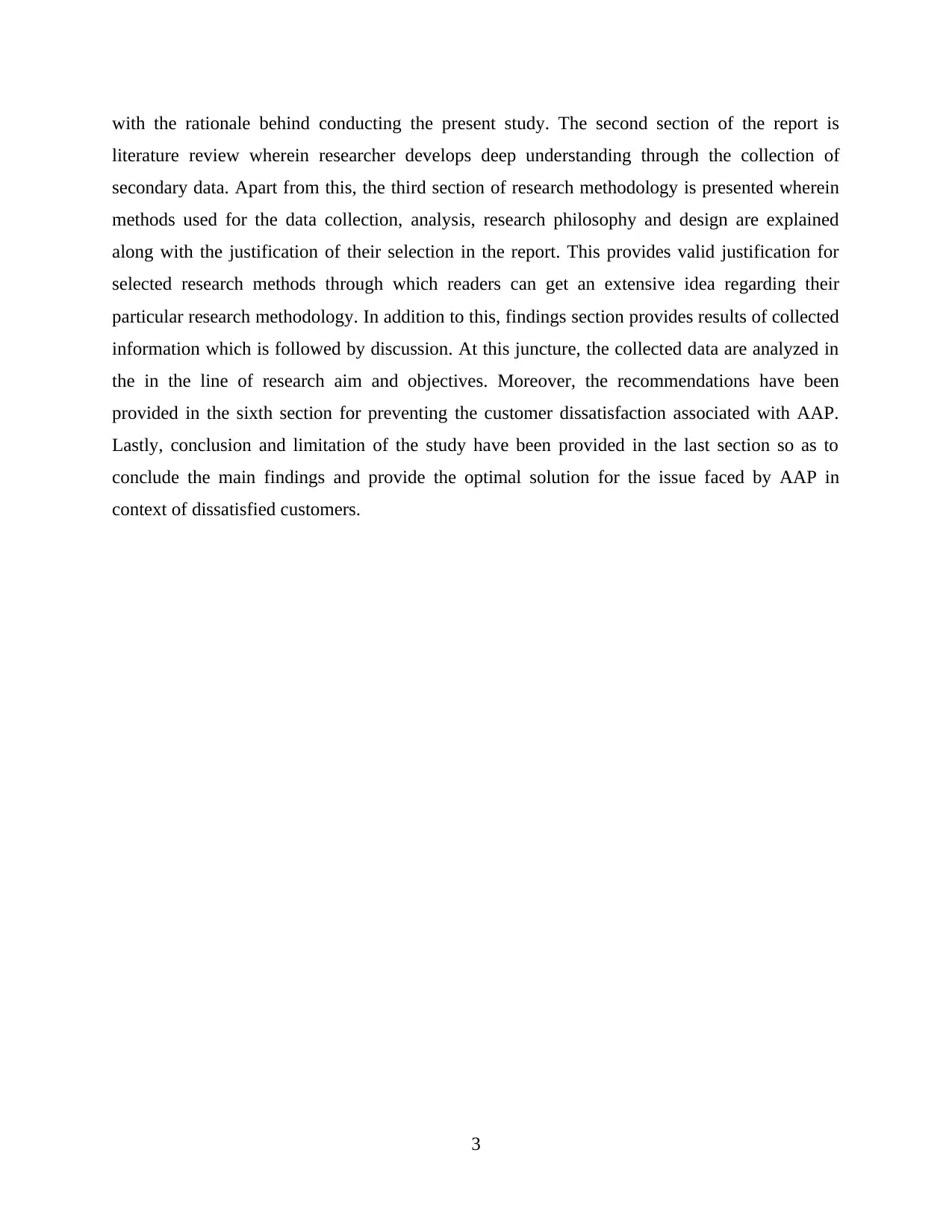
with the rationale behind conducting the present study. The second section of the report is
literature review wherein researcher develops deep understanding through the collection of
secondary data. Apart from this, the third section of research methodology is presented wherein
methods used for the data collection, analysis, research philosophy and design are explained
along with the justification of their selection in the report. This provides valid justification for
selected research methods through which readers can get an extensive idea regarding their
particular research methodology. In addition to this, findings section provides results of collected
information which is followed by discussion. At this juncture, the collected data are analyzed in
the in the line of research aim and objectives. Moreover, the recommendations have been
provided in the sixth section for preventing the customer dissatisfaction associated with AAP.
Lastly, conclusion and limitation of the study have been provided in the last section so as to
conclude the main findings and provide the optimal solution for the issue faced by AAP in
context of dissatisfied customers.
3
literature review wherein researcher develops deep understanding through the collection of
secondary data. Apart from this, the third section of research methodology is presented wherein
methods used for the data collection, analysis, research philosophy and design are explained
along with the justification of their selection in the report. This provides valid justification for
selected research methods through which readers can get an extensive idea regarding their
particular research methodology. In addition to this, findings section provides results of collected
information which is followed by discussion. At this juncture, the collected data are analyzed in
the in the line of research aim and objectives. Moreover, the recommendations have been
provided in the sixth section for preventing the customer dissatisfaction associated with AAP.
Lastly, conclusion and limitation of the study have been provided in the last section so as to
conclude the main findings and provide the optimal solution for the issue faced by AAP in
context of dissatisfied customers.
3
Paraphrase This Document
Need a fresh take? Get an instant paraphrase of this document with our AI Paraphraser
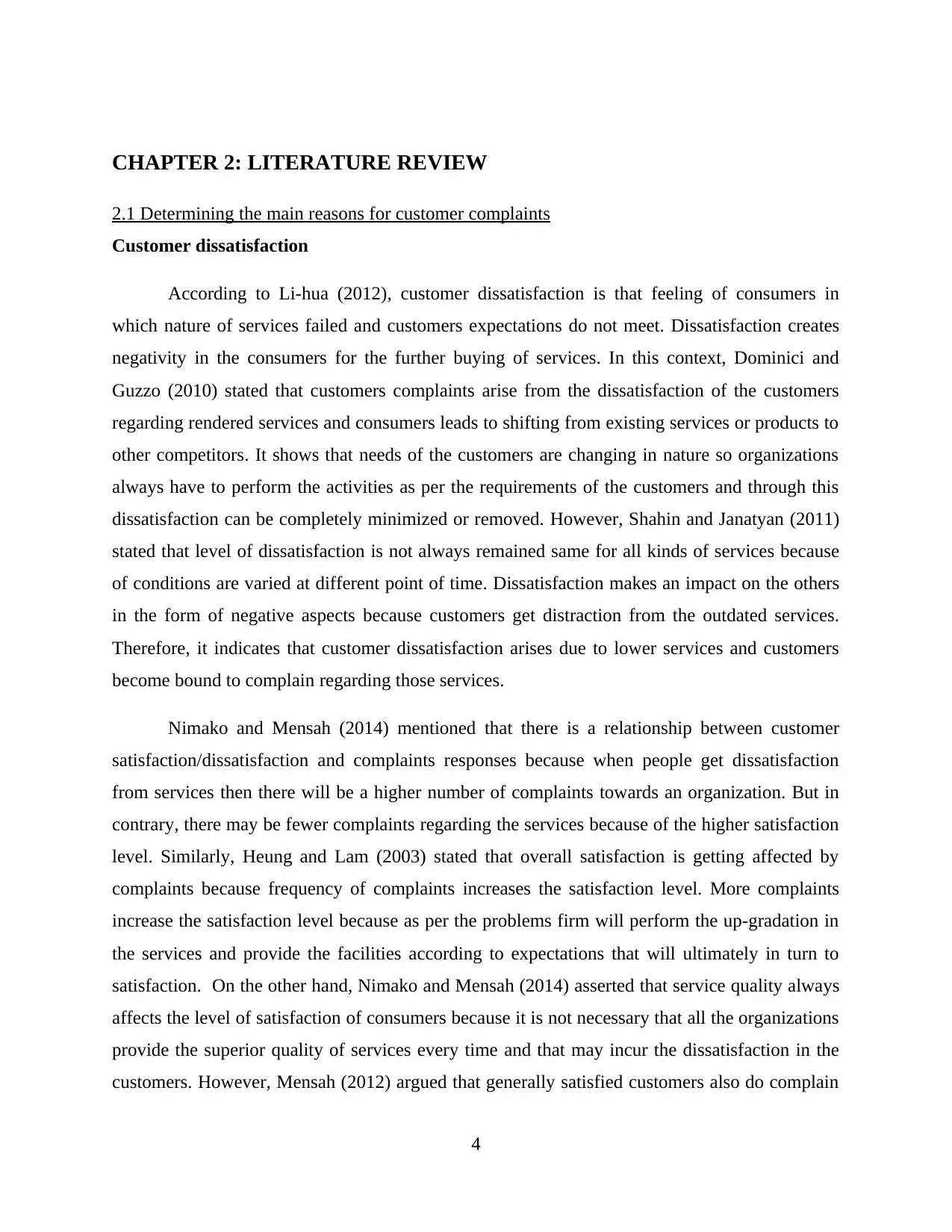
CHAPTER 2: LITERATURE REVIEW
2.1 Determining the main reasons for customer complaints
Customer dissatisfaction
According to Li-hua (2012), customer dissatisfaction is that feeling of consumers in
which nature of services failed and customers expectations do not meet. Dissatisfaction creates
negativity in the consumers for the further buying of services. In this context, Dominici and
Guzzo (2010) stated that customers complaints arise from the dissatisfaction of the customers
regarding rendered services and consumers leads to shifting from existing services or products to
other competitors. It shows that needs of the customers are changing in nature so organizations
always have to perform the activities as per the requirements of the customers and through this
dissatisfaction can be completely minimized or removed. However, Shahin and Janatyan (2011)
stated that level of dissatisfaction is not always remained same for all kinds of services because
of conditions are varied at different point of time. Dissatisfaction makes an impact on the others
in the form of negative aspects because customers get distraction from the outdated services.
Therefore, it indicates that customer dissatisfaction arises due to lower services and customers
become bound to complain regarding those services.
Nimako and Mensah (2014) mentioned that there is a relationship between customer
satisfaction/dissatisfaction and complaints responses because when people get dissatisfaction
from services then there will be a higher number of complaints towards an organization. But in
contrary, there may be fewer complaints regarding the services because of the higher satisfaction
level. Similarly, Heung and Lam (2003) stated that overall satisfaction is getting affected by
complaints because frequency of complaints increases the satisfaction level. More complaints
increase the satisfaction level because as per the problems firm will perform the up-gradation in
the services and provide the facilities according to expectations that will ultimately in turn to
satisfaction. On the other hand, Nimako and Mensah (2014) asserted that service quality always
affects the level of satisfaction of consumers because it is not necessary that all the organizations
provide the superior quality of services every time and that may incur the dissatisfaction in the
customers. However, Mensah (2012) argued that generally satisfied customers also do complain
4
2.1 Determining the main reasons for customer complaints
Customer dissatisfaction
According to Li-hua (2012), customer dissatisfaction is that feeling of consumers in
which nature of services failed and customers expectations do not meet. Dissatisfaction creates
negativity in the consumers for the further buying of services. In this context, Dominici and
Guzzo (2010) stated that customers complaints arise from the dissatisfaction of the customers
regarding rendered services and consumers leads to shifting from existing services or products to
other competitors. It shows that needs of the customers are changing in nature so organizations
always have to perform the activities as per the requirements of the customers and through this
dissatisfaction can be completely minimized or removed. However, Shahin and Janatyan (2011)
stated that level of dissatisfaction is not always remained same for all kinds of services because
of conditions are varied at different point of time. Dissatisfaction makes an impact on the others
in the form of negative aspects because customers get distraction from the outdated services.
Therefore, it indicates that customer dissatisfaction arises due to lower services and customers
become bound to complain regarding those services.
Nimako and Mensah (2014) mentioned that there is a relationship between customer
satisfaction/dissatisfaction and complaints responses because when people get dissatisfaction
from services then there will be a higher number of complaints towards an organization. But in
contrary, there may be fewer complaints regarding the services because of the higher satisfaction
level. Similarly, Heung and Lam (2003) stated that overall satisfaction is getting affected by
complaints because frequency of complaints increases the satisfaction level. More complaints
increase the satisfaction level because as per the problems firm will perform the up-gradation in
the services and provide the facilities according to expectations that will ultimately in turn to
satisfaction. On the other hand, Nimako and Mensah (2014) asserted that service quality always
affects the level of satisfaction of consumers because it is not necessary that all the organizations
provide the superior quality of services every time and that may incur the dissatisfaction in the
customers. However, Mensah (2012) argued that generally satisfied customers also do complain
4
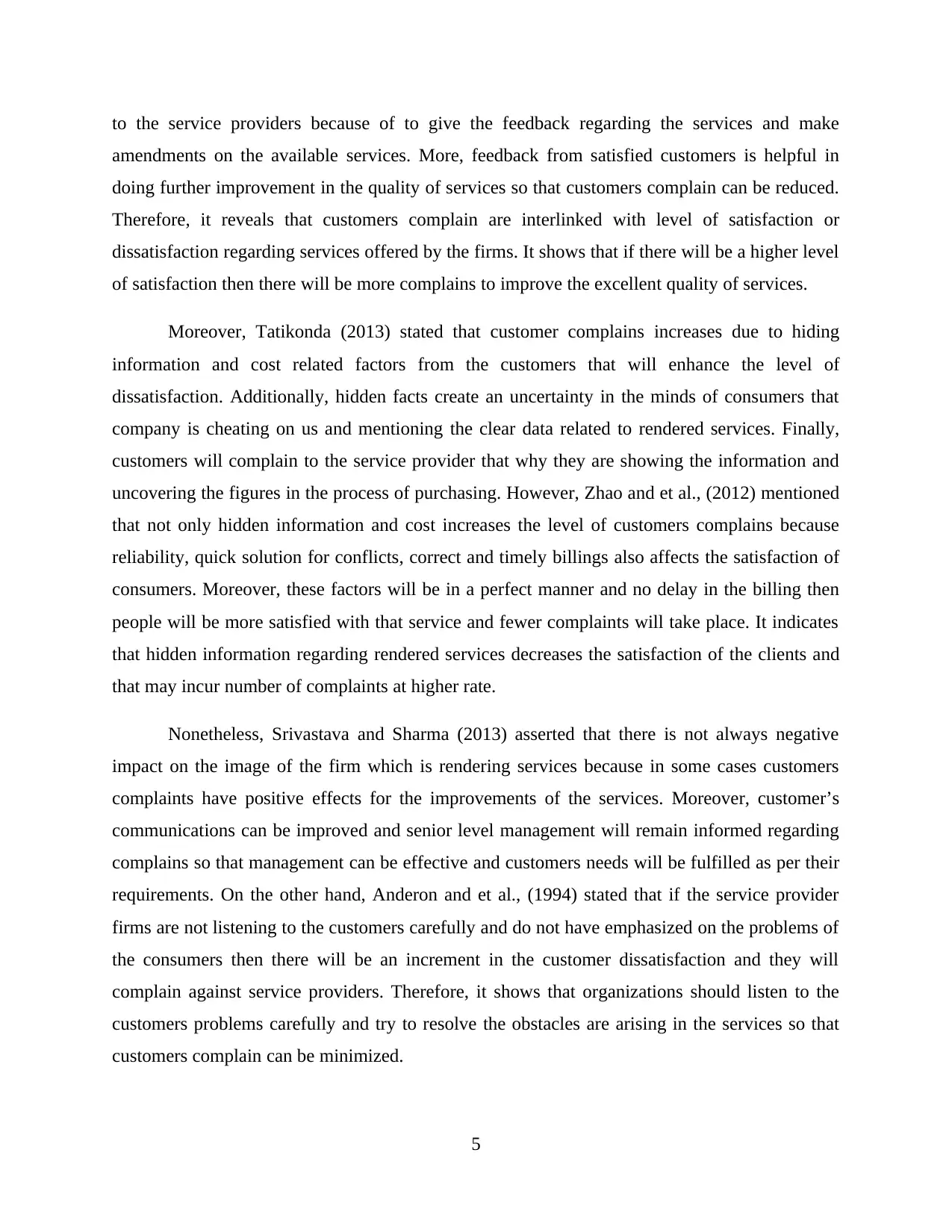
to the service providers because of to give the feedback regarding the services and make
amendments on the available services. More, feedback from satisfied customers is helpful in
doing further improvement in the quality of services so that customers complain can be reduced.
Therefore, it reveals that customers complain are interlinked with level of satisfaction or
dissatisfaction regarding services offered by the firms. It shows that if there will be a higher level
of satisfaction then there will be more complains to improve the excellent quality of services.
Moreover, Tatikonda (2013) stated that customer complains increases due to hiding
information and cost related factors from the customers that will enhance the level of
dissatisfaction. Additionally, hidden facts create an uncertainty in the minds of consumers that
company is cheating on us and mentioning the clear data related to rendered services. Finally,
customers will complain to the service provider that why they are showing the information and
uncovering the figures in the process of purchasing. However, Zhao and et al., (2012) mentioned
that not only hidden information and cost increases the level of customers complains because
reliability, quick solution for conflicts, correct and timely billings also affects the satisfaction of
consumers. Moreover, these factors will be in a perfect manner and no delay in the billing then
people will be more satisfied with that service and fewer complaints will take place. It indicates
that hidden information regarding rendered services decreases the satisfaction of the clients and
that may incur number of complaints at higher rate.
Nonetheless, Srivastava and Sharma (2013) asserted that there is not always negative
impact on the image of the firm which is rendering services because in some cases customers
complaints have positive effects for the improvements of the services. Moreover, customer’s
communications can be improved and senior level management will remain informed regarding
complains so that management can be effective and customers needs will be fulfilled as per their
requirements. On the other hand, Anderon and et al., (1994) stated that if the service provider
firms are not listening to the customers carefully and do not have emphasized on the problems of
the consumers then there will be an increment in the customer dissatisfaction and they will
complain against service providers. Therefore, it shows that organizations should listen to the
customers problems carefully and try to resolve the obstacles are arising in the services so that
customers complain can be minimized.
5
amendments on the available services. More, feedback from satisfied customers is helpful in
doing further improvement in the quality of services so that customers complain can be reduced.
Therefore, it reveals that customers complain are interlinked with level of satisfaction or
dissatisfaction regarding services offered by the firms. It shows that if there will be a higher level
of satisfaction then there will be more complains to improve the excellent quality of services.
Moreover, Tatikonda (2013) stated that customer complains increases due to hiding
information and cost related factors from the customers that will enhance the level of
dissatisfaction. Additionally, hidden facts create an uncertainty in the minds of consumers that
company is cheating on us and mentioning the clear data related to rendered services. Finally,
customers will complain to the service provider that why they are showing the information and
uncovering the figures in the process of purchasing. However, Zhao and et al., (2012) mentioned
that not only hidden information and cost increases the level of customers complains because
reliability, quick solution for conflicts, correct and timely billings also affects the satisfaction of
consumers. Moreover, these factors will be in a perfect manner and no delay in the billing then
people will be more satisfied with that service and fewer complaints will take place. It indicates
that hidden information regarding rendered services decreases the satisfaction of the clients and
that may incur number of complaints at higher rate.
Nonetheless, Srivastava and Sharma (2013) asserted that there is not always negative
impact on the image of the firm which is rendering services because in some cases customers
complaints have positive effects for the improvements of the services. Moreover, customer’s
communications can be improved and senior level management will remain informed regarding
complains so that management can be effective and customers needs will be fulfilled as per their
requirements. On the other hand, Anderon and et al., (1994) stated that if the service provider
firms are not listening to the customers carefully and do not have emphasized on the problems of
the consumers then there will be an increment in the customer dissatisfaction and they will
complain against service providers. Therefore, it shows that organizations should listen to the
customers problems carefully and try to resolve the obstacles are arising in the services so that
customers complain can be minimized.
5
⊘ This is a preview!⊘
Do you want full access?
Subscribe today to unlock all pages.

Trusted by 1+ million students worldwide
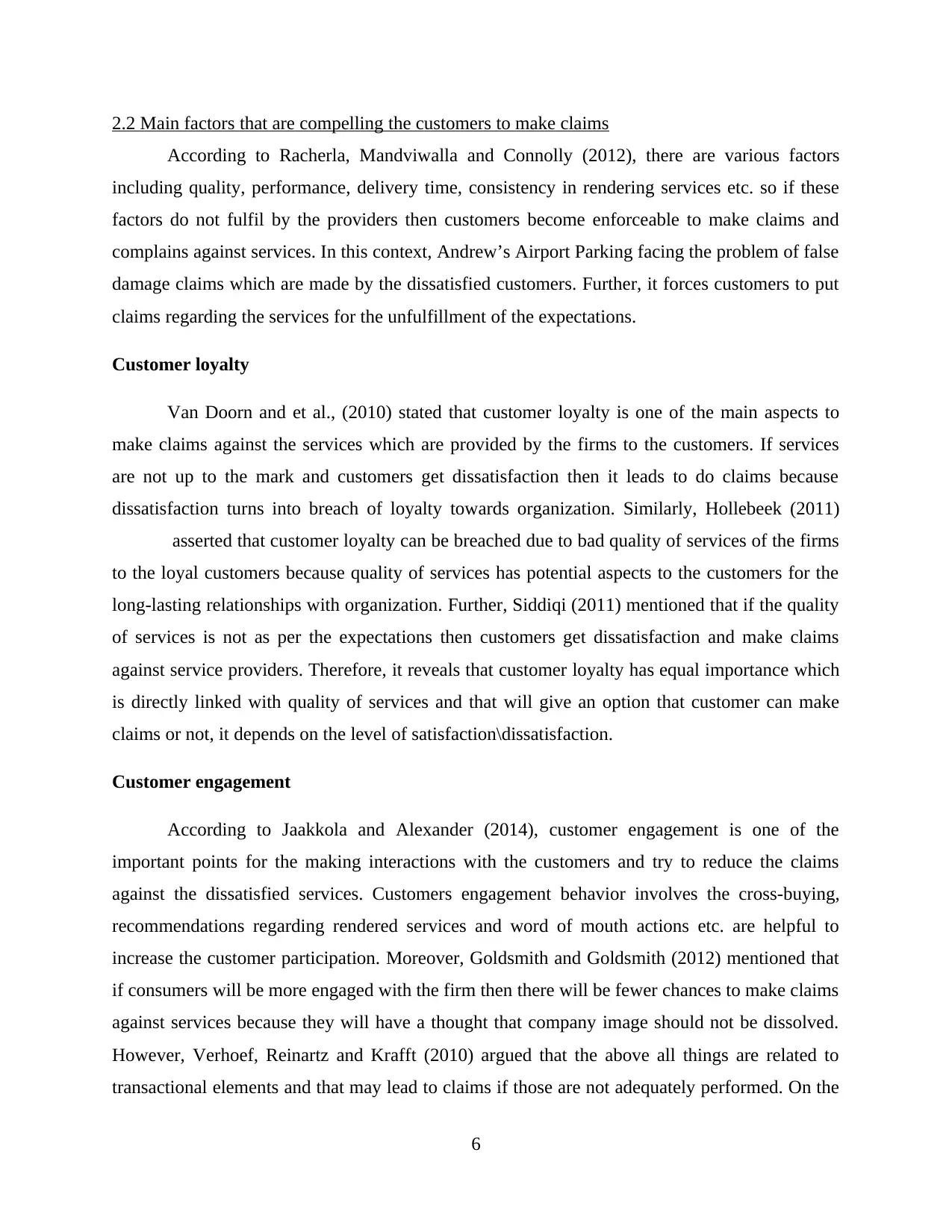
2.2 Main factors that are compelling the customers to make claims
According to Racherla, Mandviwalla and Connolly (2012), there are various factors
including quality, performance, delivery time, consistency in rendering services etc. so if these
factors do not fulfil by the providers then customers become enforceable to make claims and
complains against services. In this context, Andrew’s Airport Parking facing the problem of false
damage claims which are made by the dissatisfied customers. Further, it forces customers to put
claims regarding the services for the unfulfillment of the expectations.
Customer loyalty
Van Doorn and et al., (2010) stated that customer loyalty is one of the main aspects to
make claims against the services which are provided by the firms to the customers. If services
are not up to the mark and customers get dissatisfaction then it leads to do claims because
dissatisfaction turns into breach of loyalty towards organization. Similarly, Hollebeek (2011)
asserted that customer loyalty can be breached due to bad quality of services of the firms
to the loyal customers because quality of services has potential aspects to the customers for the
long-lasting relationships with organization. Further, Siddiqi (2011) mentioned that if the quality
of services is not as per the expectations then customers get dissatisfaction and make claims
against service providers. Therefore, it reveals that customer loyalty has equal importance which
is directly linked with quality of services and that will give an option that customer can make
claims or not, it depends on the level of satisfaction\dissatisfaction.
Customer engagement
According to Jaakkola and Alexander (2014), customer engagement is one of the
important points for the making interactions with the customers and try to reduce the claims
against the dissatisfied services. Customers engagement behavior involves the cross-buying,
recommendations regarding rendered services and word of mouth actions etc. are helpful to
increase the customer participation. Moreover, Goldsmith and Goldsmith (2012) mentioned that
if consumers will be more engaged with the firm then there will be fewer chances to make claims
against services because they will have a thought that company image should not be dissolved.
However, Verhoef, Reinartz and Krafft (2010) argued that the above all things are related to
transactional elements and that may lead to claims if those are not adequately performed. On the
6
According to Racherla, Mandviwalla and Connolly (2012), there are various factors
including quality, performance, delivery time, consistency in rendering services etc. so if these
factors do not fulfil by the providers then customers become enforceable to make claims and
complains against services. In this context, Andrew’s Airport Parking facing the problem of false
damage claims which are made by the dissatisfied customers. Further, it forces customers to put
claims regarding the services for the unfulfillment of the expectations.
Customer loyalty
Van Doorn and et al., (2010) stated that customer loyalty is one of the main aspects to
make claims against the services which are provided by the firms to the customers. If services
are not up to the mark and customers get dissatisfaction then it leads to do claims because
dissatisfaction turns into breach of loyalty towards organization. Similarly, Hollebeek (2011)
asserted that customer loyalty can be breached due to bad quality of services of the firms
to the loyal customers because quality of services has potential aspects to the customers for the
long-lasting relationships with organization. Further, Siddiqi (2011) mentioned that if the quality
of services is not as per the expectations then customers get dissatisfaction and make claims
against service providers. Therefore, it reveals that customer loyalty has equal importance which
is directly linked with quality of services and that will give an option that customer can make
claims or not, it depends on the level of satisfaction\dissatisfaction.
Customer engagement
According to Jaakkola and Alexander (2014), customer engagement is one of the
important points for the making interactions with the customers and try to reduce the claims
against the dissatisfied services. Customers engagement behavior involves the cross-buying,
recommendations regarding rendered services and word of mouth actions etc. are helpful to
increase the customer participation. Moreover, Goldsmith and Goldsmith (2012) mentioned that
if consumers will be more engaged with the firm then there will be fewer chances to make claims
against services because they will have a thought that company image should not be dissolved.
However, Verhoef, Reinartz and Krafft (2010) argued that the above all things are related to
transactional elements and that may lead to claims if those are not adequately performed. On the
6
Paraphrase This Document
Need a fresh take? Get an instant paraphrase of this document with our AI Paraphraser
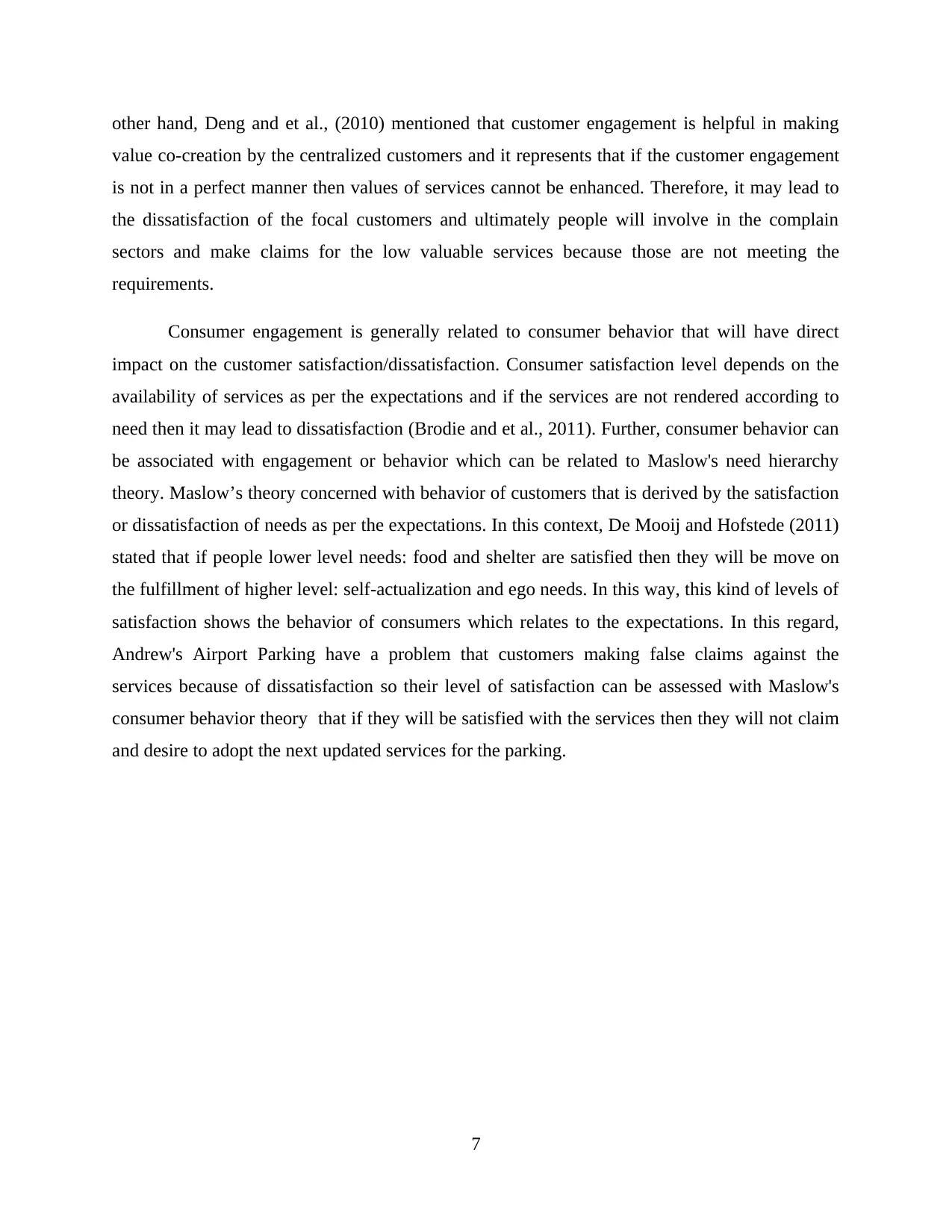
other hand, Deng and et al., (2010) mentioned that customer engagement is helpful in making
value co-creation by the centralized customers and it represents that if the customer engagement
is not in a perfect manner then values of services cannot be enhanced. Therefore, it may lead to
the dissatisfaction of the focal customers and ultimately people will involve in the complain
sectors and make claims for the low valuable services because those are not meeting the
requirements.
Consumer engagement is generally related to consumer behavior that will have direct
impact on the customer satisfaction/dissatisfaction. Consumer satisfaction level depends on the
availability of services as per the expectations and if the services are not rendered according to
need then it may lead to dissatisfaction (Brodie and et al., 2011). Further, consumer behavior can
be associated with engagement or behavior which can be related to Maslow's need hierarchy
theory. Maslow’s theory concerned with behavior of customers that is derived by the satisfaction
or dissatisfaction of needs as per the expectations. In this context, De Mooij and Hofstede (2011)
stated that if people lower level needs: food and shelter are satisfied then they will be move on
the fulfillment of higher level: self-actualization and ego needs. In this way, this kind of levels of
satisfaction shows the behavior of consumers which relates to the expectations. In this regard,
Andrew's Airport Parking have a problem that customers making false claims against the
services because of dissatisfaction so their level of satisfaction can be assessed with Maslow's
consumer behavior theory that if they will be satisfied with the services then they will not claim
and desire to adopt the next updated services for the parking.
7
value co-creation by the centralized customers and it represents that if the customer engagement
is not in a perfect manner then values of services cannot be enhanced. Therefore, it may lead to
the dissatisfaction of the focal customers and ultimately people will involve in the complain
sectors and make claims for the low valuable services because those are not meeting the
requirements.
Consumer engagement is generally related to consumer behavior that will have direct
impact on the customer satisfaction/dissatisfaction. Consumer satisfaction level depends on the
availability of services as per the expectations and if the services are not rendered according to
need then it may lead to dissatisfaction (Brodie and et al., 2011). Further, consumer behavior can
be associated with engagement or behavior which can be related to Maslow's need hierarchy
theory. Maslow’s theory concerned with behavior of customers that is derived by the satisfaction
or dissatisfaction of needs as per the expectations. In this context, De Mooij and Hofstede (2011)
stated that if people lower level needs: food and shelter are satisfied then they will be move on
the fulfillment of higher level: self-actualization and ego needs. In this way, this kind of levels of
satisfaction shows the behavior of consumers which relates to the expectations. In this regard,
Andrew's Airport Parking have a problem that customers making false claims against the
services because of dissatisfaction so their level of satisfaction can be assessed with Maslow's
consumer behavior theory that if they will be satisfied with the services then they will not claim
and desire to adopt the next updated services for the parking.
7
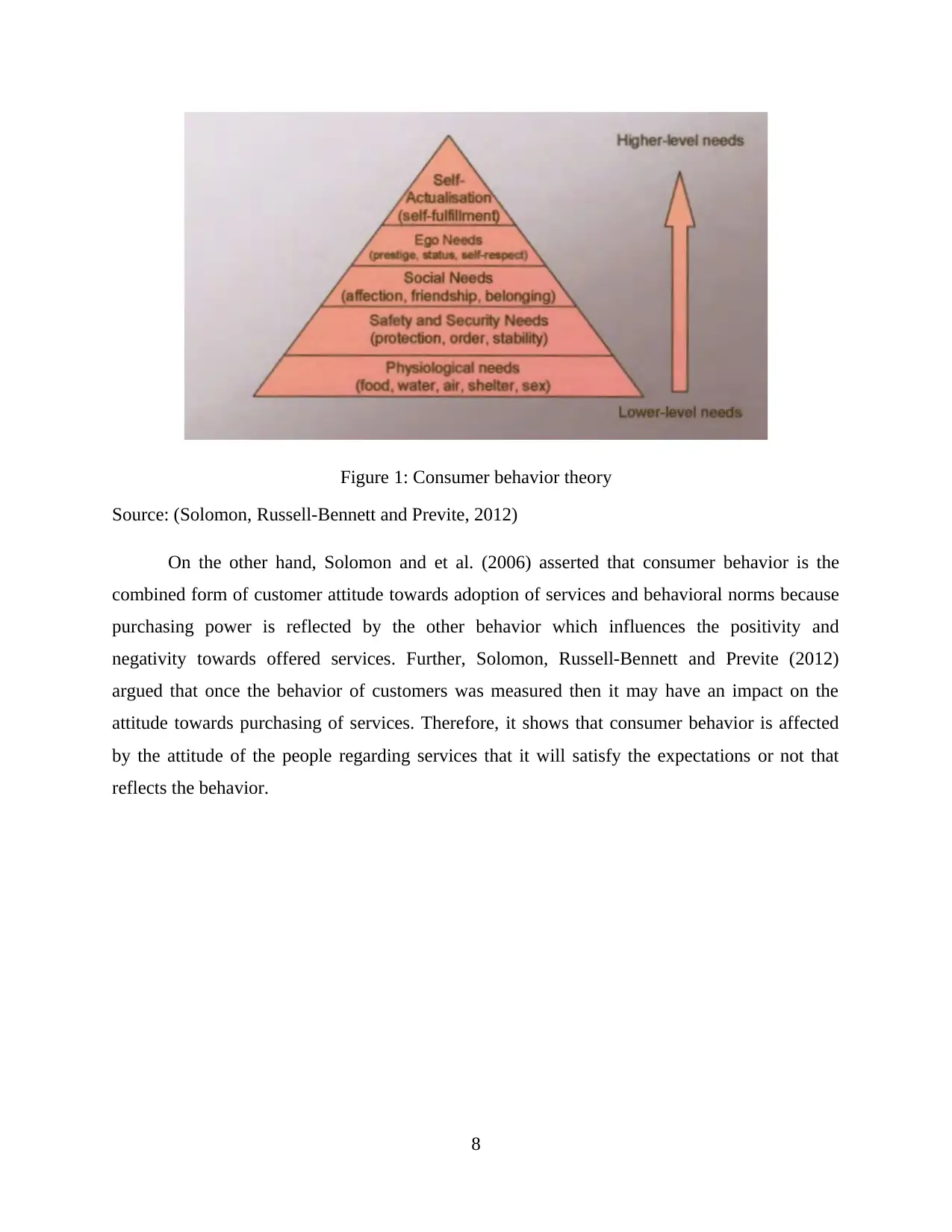
Figure 1: Consumer behavior theory
Source: (Solomon, Russell-Bennett and Previte, 2012)
On the other hand, Solomon and et al. (2006) asserted that consumer behavior is the
combined form of customer attitude towards adoption of services and behavioral norms because
purchasing power is reflected by the other behavior which influences the positivity and
negativity towards offered services. Further, Solomon, Russell-Bennett and Previte (2012)
argued that once the behavior of customers was measured then it may have an impact on the
attitude towards purchasing of services. Therefore, it shows that consumer behavior is affected
by the attitude of the people regarding services that it will satisfy the expectations or not that
reflects the behavior.
8
Source: (Solomon, Russell-Bennett and Previte, 2012)
On the other hand, Solomon and et al. (2006) asserted that consumer behavior is the
combined form of customer attitude towards adoption of services and behavioral norms because
purchasing power is reflected by the other behavior which influences the positivity and
negativity towards offered services. Further, Solomon, Russell-Bennett and Previte (2012)
argued that once the behavior of customers was measured then it may have an impact on the
attitude towards purchasing of services. Therefore, it shows that consumer behavior is affected
by the attitude of the people regarding services that it will satisfy the expectations or not that
reflects the behavior.
8
⊘ This is a preview!⊘
Do you want full access?
Subscribe today to unlock all pages.

Trusted by 1+ million students worldwide
1 out of 45
Related Documents
Your All-in-One AI-Powered Toolkit for Academic Success.
+13062052269
info@desklib.com
Available 24*7 on WhatsApp / Email
![[object Object]](/_next/static/media/star-bottom.7253800d.svg)
Unlock your academic potential
Copyright © 2020–2025 A2Z Services. All Rights Reserved. Developed and managed by ZUCOL.





